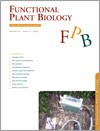
Functional Plant Biology
Volume 41 Number 3 2014
FP10900PrometheusWiki Gold Leaf Protocol: gas exchange using LI-COR 6400
FP10900 Abstract | FP10900 Full Text | FP10900PDF (480 KB) | FP10900Supplementary Material (2.1 MB) Open Access Article
FP13221Identification of stay-green and early senescence phenotypes in high-yielding winter wheat, and their relationship to grain yield and grain protein concentration using high-throughput phenotyping techniques
Maintenance of green leaf area is important for maximum yield formation and for high grain protein concentration. A high-throughput phenotyping method to identify stay-green and early senescence phenotypes was developed. The findings contribute to a better understanding of senescence processes.
FP13155Assessment of cultivated and wild, weedy rice lines to concurrent changes in CO2 concentration and air temperature: determining traits for enhanced seed yield with increasing atmospheric CO2
One means to select crops that are adapted to rising atmospheric carbon dioxide (CO2) is to determine which varieties can best convert CO2 into seed yield at higher temperatures.. We did this for rice, and found that although all lines responded with more seed yield as CO2 increased, the weedy line, ‘Stg-S’ increased seed yields even at day/night temperatures up to 33/25°C. Our results suggest that including novel genes from weedy lines could help in adapting crops like rice to future climate change.
FP13067Drought-induced mortality selectively affects Scots pine trees that show limited intrinsic water-use efficiency responsiveness to raising atmospheric CO2
Drought-induced tree mortality mechanisms are yet to be fully understood. We found that co-occurring now-dead and surviving Scots pines increased their intrinsic water-use efficiency over time, although the former increased it at significantly lower rates than the latter in the period prior to death. Warmer/drier climatic conditions could increase tree mortality in the Mediterranean: our results provide a possible approach to identify vulnerable pines.
FP13211Conservative water use under high evaporative demand associated with smaller root metaxylem and limited trans-membrane water transport in wheat
Wheat yields are increasingly limited by drought events occurring at a global scale, making it important to identify drought-tolerance mechanisms. Here we report an investigation into the basis of the exceptional drought tolerance capability exhibited by an elite breeding line (RAC875) that is being used in several international breeding programs. Our data suggests that this line owes its drought tolerance to a water-saving strategy, provided by specific root anatomical and functional features that restrict water loss by transpiration under high evaporative demand.
FP13246Hydraulic conductance differences among sorghum genotypes to explain variation in restricted transpiration rates
Drought causes yield loss in sorghum, as in virtually all crops. This research was done to understand water transport in sorghum plants as a mechanism to regulate water loss and to increase yield under drought. Genetic variation for plant water transport properties was found. This variation corresponded to variation in plant water loss under dry-air conditions, indicating that it may be possible to breed sorghum varieties with low water transport properties to increase drought tolerance.
FP13202Root growth and anchorage by transplanted ‘Tifgreen’ (Cynodon dactylon x C. transvaalensis) turfgrass
Rapid turfgrass establishment from transplanted sod is economically and aesthetically important. Anchoring of hybrid Cynodon (bermudagrass or couch) sod to underlying soil by new roots was strongly affected by transplantation date in springtime and by soil texture, but not by N-P-K fertilisation; irrigation overcame any effects of dry soil on root elongation rate. This new understanding of root growth by transplanted Cynodon sod can improve turfgrass cultural practice strategies.
FP13137Seasonality of foliar respiration in two dominant plant species from the Arctic tundra: response to long-term warming and short-term temperature variability
Rapid warming in the Arctic is causing cascading changes, many of which influence how carbon is cycled and stored. Photosynthesis and respiration, the leaf-level processes that control the capture and release of CO2, can vary across species and under long-term warming, which is important, considering the warmer tundra of the future. The results present alterations in physiological processes and can inform predictive models of carbon cycling in this region.
FP13210Interspecific variation in functional traits in relation to species climatic niche optima in Andean Polylepis (Rosaceae) tree species: evidence for climatic adaptations
High elevation plants show genetically determined adaptations and phenotypically plastic acclimations in their functional traits as a response to environmental conditions. We found that 7 of 14 studied traits that enable Andean Polylepis trees to withstand cold and dry conditions show genetically determined variation among the nine species that were studied. This suggests that these traits have been important targets of selection during the evolution of high-Andean Polylepis species.
FP13184Chemical composition of cuticular waxes during fruit development of Pingguoli pear and their potential role on early events of Alternaria alternata infection
The cuticle of a plant has a dual role (prevention or facilitation of fungal invasion) in the process of infection. Changes in chemical composition of wax during fruit development of Pingguoli pear and their role in Alternaria alternata infection were evaluated in this study. Results showed that the infection processes of A. alternata was prevented or stimulated depending on the chemical composition of the wax. These findings may offer new light on the chemical basis for wax involvement in fungal infection.
FP12388Characterisation of DGAT1 and DGAT2 from Jatropha curcas and their functions in storage lipid biosynthesis
Two key enzyme DGAT genes for lipid biosynthesis, JcDGAT1 and JcDGAT2, were cloned and characterised from the potential biodiesel plant Jatropha curcas. The functional divergence of JcDGAT1 and JcDGAT2 in lipid biosynthesis was demonstrated by comparing the oil content and fatty acid compositions in both the transgenic yeast and tobacco systems. JcDGAT2 exhibited an obvious linoleic acid substrate preference in both transgenic yeast and tobacco systems.




